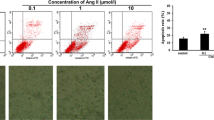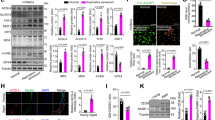Abstract
Replicative senescence of vascular smooth muscle cells (VSMCs) contributes to aging as well as age-related cardiovascular diseases. Rapamycin can delay the onset of aging-related diseases via inhibition of the mammalian target of rapamycin (mTOR), but its role in vascular aging remains elusive. This study investigated the involvement of mTOR signaling in replicative senescence of VSMCs. Replicative senescence was induced by the extended passages of human VSMCs. Aging-related cell morphology was observed. The aging-related proteins and enzyme activity, and oxidative stress were measured. Significant increase in SA-β-gal activity and protein expression, p53 and p16 protein expression, proliferation index (PI), malondialdehyde (MDA) concentration, superoxide dismutase (SOD) and glutathione peroxidase (GPX) activity, and significant decrease in telomerase activity was observed in aging VSMCs compared to young cells. Significant activation of PI3K/Akt/mTOR signaling was observed in aging cells but not young cells. Pretreatment of VSMCs with PI3K inhibitor blocked while PI3K activator increased the changes of the above replicative senescence-related parameters in VSMCs. Rapamycin and silencing of mTOR expression inhibited replicative senescence in VSMCs through decreasing the level of p-mTOR Ser2448, p-mTOR Thr2446, and S6K1 phosphorylation. This study for the first time demonstrated that the PI3K/Akt/mTOR/S6K1 signal pathway plays an important role in regulating replicative senescence of human VSMCs.







Similar content being viewed by others
References
Fontana L, Partridge L, Longo VD (2010) Extending healthy life span from yeast to humans. Science 328:321–326
Harrison DE, Strong R, Sharp ZD, Nelson JF, Astle CM, Flurkey K, Nadon NL, Wilkinson JE, Frenkel K, Carter CS, Pahor M, Javors MA, Fernandez E, Miller RA (2009) Rapamycin fed late in life extends lifespan in genetically heterogeneous mice. Nature 460:392–395
Miller RA, Harrison DE, Astle CM, Baur JA, Boyd AR, de Cabo R, Fernandez E, Flurkey K, Javors MA, Nelson JF, Orihuela CJ, Pletcher S, Sharp ZD, Sinclair D, Starnes JW, Wilkinson JE, Nadon NL, Strong R (2011) Rapamycin, but not resveratrol or simvastatin, extends life span of genetically heterogeneous mice. J Gerontol A Biol Sci Med Sci 66:191–201
Goldberg EL, Romero-Aleshire MJ, Ventevogel MS, Chew WM, Uhrlaub JL, Smithey MJ, Limesand KH, Sempowski GD, Brooks HL, Nikolich-Žugich J (2015) Lifespan-extending caloric restriction or mTOR inhibition impair adaptive immunity of old mice by distinct mechanisms. Aging Cell 14:130–138
Zoncu R, Efeyan A, Sabatini DM (2011) mTOR: from growth signal integration to cancer, diabetes and ageing. Nat Rev Mol Cell Biol 12:21–35
Lim MA, Townsend RR (2009) Arterial compliance in the elderly: its effect on blood pressure measurement and cardiovascular outcomes. Clin Geriatr Med 25:191–205
Ungvari Z, Kaley G, de Cabo R, Sonntag WE, Csiszar A (2010) Mechanisms of vascular aging: new perspectives. J Gerontol A Biol Sci Med Sci 65:1028–1041
von Zglinicki T, Petrie J, Kirkwood TB (2003) Telomere-driven replicative senescence is a stress response. Nat Biotechnol 21:229–230
Passos JF, Von Zglinicki T (2006) Oxygen free radicals in cell senescence: are they signal transducers? Free Radic Res 40:1277–1283
Unterluggauer H, Hutter E, Voglauer R, Grillari J, Vöth M, Bereiter-Hahn J, Jansen-Dürr P, Jendrach M (2007) Identification of cultivation-independent markers of human endothelial cell senescence in vitro. Biogerontology 8:383–397
Shanahan CM (2013) Mechanisms of vascular calcification in CKD-evidence for premature ageing? Nat Rev Nephrol 9:661–670
Lauring J, Park BH, Wolff AC (2013) The phosphoinositide-3-kinase-AktmTOR pathway as a therapeutic target in breast cancer. J Natl Compr Canc Netw 11:670–678
Hay N, Sonenberg N (2004) Upstream and downstream of mTOR. Genes Dev 18:1926–1945
Wang X, Proud CG (2011) mTORC1 signaling: what we still don’t know. J Mol Cell Biol 3:206–220
Zhan JK, Wang YJ, Wang Y, Tang ZY, Tan P, Huang W, Liu YS (2015) The protective effect of GLP-1 analogue in arterial calcification through attenuating osteoblastic differentiation of human VSMCs. Int J Cardiol 189:188–193
Zhan JK, Wang YJ, Wang Y, Wang S, Tan P, Huang W, Liu YS (2014) The mammalian target of rapamycin signalling pathway is involved in osteoblastic differentiation of vascular smooth muscle cells. Can J Cardiol 30:568–575
Zhan JK, Wang YJ, Wang Y, Tang ZY, Tan P, Huang W, Liu YS (2014) Adiponectin attenuates the osteoblastic differentiation of vascular smooth muscle cells through the AMPK/mTOR pathway. Exp Cell Res 323:352–358
Dimri GP, Lee X, Basile G, Acosta M, Scott G, Roskelley C, Medrano EE, Linskens M, Rubelj I, Pereira-Smith O et al (1995) A biomarker that identifies senescent human cells in culture and in aging skin in vivo. Proc Natl Acad Sci USA 92:9363–9367
Draper H, Hadley M (1990) Malondialdehyde determination as index of lipid peroxidation. Methods Enzymol 186:421–431
Kakkar P, Das B, Viswanathan PN (1984) A modified spectrophotometric assay of superoxide dismutase. Ind J Biochem Biophy 21:130–132
Liang QH, Jiang Y, Zhu X, Cui RR, Liu GY, Liu Y, Wu SS, Liao XB, Xie H, Zhou HD, Wu XP, Yuan LQ, Liao EY (2012) Ghrelin attenuates the osteoblastic differentiation of vascular smooth muscle cells through the ERK pathway. PLoS One 7:e33126
Houde VP, Brule S, Festuccia WT, Blanchard PG, Bellmann K, Deshaies Y, Marette A (2010) Chronic rapamycin treatment causes glucose intolerance and hyperlipidemia by upregulating hepatic gluconeogenesis and impairing lipid deposition in adipose tissue. Diabetes 59:1338–1348
Ming XF, Montani JP, Yang Z (2012) Perspectives of targeting mTORC1-S6K1 in cardiovascular aging. Front Physiol 25:5
Marchand A, Atassi F, Gaaya A, Leprince P, Le Feuvre C, Soubrier F, Lompré AM, Nadaud S (2011) The Wnt/beta-catenin pathway is activated during advanced arterial aging in humans. Aging Cell 10:220–232
Liu S, Liu S, Wang X, Zhou J, Cao Y, Wang F, Duan E (2011) The PI3K-Akt pathway inhibits senescence and promotes self-renewal of human skin-derived precursors in vitro. Aging Cell 10:661–674
Kloet DE, Burgering BM (2011) The PKB/FOXO switch in aging and cancer. Biochim Biophys Acta 1813:1926–1937
Langley E, Pearson M, Faretta M, Bauer UM, Frye RA, Minucci S, Pelicci PG, Kouzarides T (2002) Human SIR2 deacetylates p53 and antagonizes PML/p53-induced cellular senescence. EMBO J 21:2383–2396
Kunieda T, Minamino T, Nishi J, Tateno K, Oyama T, Katsuno T, Miyauchi H, Orimo M, Okada S, Takamura M, Nagai T, Kaneko S, Komuro I (2006) Angiotensin Òinduces premature senescence of vascular smooth muscle cells and accelerates the development of atherosclerosis via a p21-dependent pathway. Circulation 114:953–960
Unterluggauer H, Hutter E, Voglauer R, Grillari J, Vöth M, Bereiter-Hahn J, Jansen-Dürr P, Jendrach M (2007) Identification of cultivation-independent markers of human endothelial cell senescence in vitro. Biogerontology 8:383–397
Polager S, Ginsberg D (2009) p53 and E2f: partners in life and death. Nat Rev Cancer 9:738–748
Cheng SW, Fryer LG, Carling D, Shepherd PR (2004) Thr2446 is anovel mammalian target of rapamycin (mTOR) phosphorylation site regulated by nutrient status. J Biol Chem 279:15719–15722
Peterson RT, Beal PA, Comb MJ, Schreiber SL (2000) FKBP12—rapamycin-associated protein(FRAP) autophosphorylates at serine 2481 under translationally repressive conditions. J Biol Chem 275:7416–7423
Zorić L, Colak E, Canadanović V, Kosanović-Jaković N, Kisić B (2010) Oxidation stress role in age-related cataractogenesis. Med Pregl 63:522–526
Shuvaev VV, Han J, Yu KJ, Huang S, Hawkins BJ, Madesh M, Nakada M, Muzykantov VR (2011) PECAM-targeted delivery of SOD inhibits endothelial inflammatory response. FASEB J 25:348–357
Gilley D, Herbert BS, Huda N, Tanaka H, Reed T (2008) Factors impacting human telomere homeostasis and age-related disease. Mech Ageing Dev 129:27–34
Niclauss N, Bosco D, Morel P, Giovannoni L, Berney T, Parnaud G (2011) Rapamycin impairs proliferation of transplanted islet beta cells. Transplantation 91:714–722
Tanemura M, Ohmura Y, Deguchi T, Machida T, Tsukamoto R, Wada H, Kobayashi S, Marubashi S, Eguchi H, Ito T, Nagano H, Mori M, Doki Y (2012) Rapamycin causes upregulation of autophagy and impairs islets function both in vitro and in vivo. Am J Transplant 12:102–114
Acknowledgments
This study was supported by the National Basic Research Program of China (No. 2014CB910500), the National Natural Science Foundation of China (No.81501212, No.81370931), and the Hunan Province Special Health Research Projects (A2015-04).
Author information
Authors and Affiliations
Corresponding authors
Ethics declarations
Conflicts of interest
All authors declared that they have no conflicts of interests.
Rights and permissions
About this article
Cite this article
Tan, P., Wang, YJ., Li, S. et al. The PI3K/Akt/mTOR pathway regulates the replicative senescence of human VSMCs. Mol Cell Biochem 422, 1–10 (2016). https://doi.org/10.1007/s11010-016-2796-9
Received:
Accepted:
Published:
Issue Date:
DOI: https://doi.org/10.1007/s11010-016-2796-9




